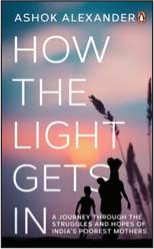Translate this page into:
Book Review: How the Light Gets In
[To cite: Desikan P. How the light gets in (Book Review). Natl Med J India 2024;37:166–7. DOI: 10.25259/NMJI_360_2024]

How the Light Gets In. Ashok Alexander. Penguin Random House, Gurugram. 364pp, ₹ 599. ISBN: 978–0–670–09421–9.
‘These kinds of challenges can only be solved by women who live with the problems everyday.’ This personal belief inspired The Antara Foundation (TAF). A non-governmental organization nurtured by Ashok Alexander, TAF works on maternal and child health. This book is a chronicle of TAF’s journey, in delivering solutions to improve maternal and child health outcomes, among India’s poorest populations. It is also a narrative of the personal transformation of the author, Ashok Alexander, from a senior partner at McKinsey & Company, to the creator of a grassroots entity operating in remote rural India.
Before starting TAF, Ashok Alexander had established Avahan, an HIV/AIDS prevention programme for the Gates Foundation, which is credited with averting over 6 lakh (0.6 million) HIV infections. Much of the author’s work with Avahan entailed understanding the world of sex workers in India. He draws parallels between sex workers and village mothers in remote rural India. Both are utterly marginalized, and have little control over their own lives. With others making vital decisions regarding their lives, both live in tough environments, in a struggle for survival.
The book has three parts, Conception, Child, and Adult, describing the evolution of TAF in its work in rural and tribal areas of Rajasthan and Madhya Pradesh. ‘Conception’ sets out describing ‘faded blossoms’—a poignant account of young mothers, their severely malnourished (often female) children, and the sheer disregard for their needs. It is the author’s dream to be able to prevent such morbid conditions, and mortality, in mothers and children. The naïve assumption that his track record with Avahan would open doors, and provide access to willing donors for TAF, soon disintegrates. There is a painful cognizance that fundraising has put him on the other side of the fence. Experiences with potential donors range from those with strings attached, to those that were truly disappointing. Experiences with the bureaucracy are a mixed bag. Reprieve comes from the Tata Trusts. His mentor in Avahan, Bill Gates, continues to be his lodestar. Vasundhara Raje Scindia, then Chief Minister of Rajasthan, provides vital support for TAF’s maternal and child health programme in partnership with the state government. The author wryly concedes that, by sticking to his dream, he has become something of a zealot. It has been a struggle to give life to his dream, he sometimes wonders how he did it, but never why.
In the second part of the book, TAF, birthed after a long and arduous effort, now enters its childhood in Rajasthan. With a mission to ensure that no woman would die giving birth, that every infant would survive and grow up healthy, TAF embarked on an ambitious task. It is clear that the team would have to move closer to the women who live with these problems, learn from them, and work with them in equal partnership. Jhalawar, in Rajasthan, becomes TAF’s first base. There is a warmth in the portrayal of life, customs, and the beauty of nature in Jhalawar and wry accounts of government constructed would-be toilets being converted into little shops. Tongue-in-cheek descriptions of individuals in the bureaucracy (Father, Son and the Holy ghost) provide the kind of gentle humour that steer the narrative away from cynicism.
Extensive field work brings a careful understanding of the existing maternal and child health system. The issues faced by the AAA workers—the Anganwadi worker (AWW), the auxiliary nurse midwife (ANM), and the accredited social health activist (ASHA), are carefully identified. In partnership with the AAA workers, the village is mapped for households with pregnant women, newborns or severely malnourished children. The AAA workers together form a platform, that, in coordination with the village women, is able to streamline maternal and child healthcare delivery. This successful platform, catalysed by TAF, is launched statewide by the Chief Minister. At this point, unexpected troubles arise, with funding sources drying up. TAF had been carefully nurtured like a baby. With its lifelines withering, it becomes a fledgeling, struggling to survive. The pain is palpable. An unexpected Foreign Contributions Regulation Act (FCRA) permit provides much needed relief by opening the gates for potential overseas donors.
The third part of the book deals with the maturing of TAF, and its entry into adulthood, in the state of Madhya Pradesh. The team tries to understand various barriers to maternal and child healthcare delivery. Family dynamics, poor roads and God-men, or ‘babas’, are some of them. Shiny, wiry and burly babas find a place in this section. However, their potential for possible help in uptake of the services of the healthcare system is not underestimated. Heartwarming descriptions of some TAF team members, as well as some AAA workers, going out on a limb to save lives, and reflections on Bill Gates’ influence on the author’s work, bring this narrative to a close.
The author’s acknowledgement of human failings being just that—human—brings an underlying compassion to the story. His epilogue ends with the quiet acceptance that it would soon be time to move away from his own creation, underlining the transience of individual roles in the larger scheme of things.
The book is available at Amazon for ₹472.69 (hard cover) and ₹449.06 (Kindle version)




